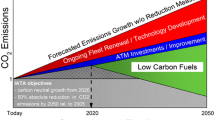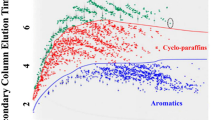Abstract
Isobaric specific heat capacities were measured for nine separate aviation turbine fuel samples. The nine samples span the range of fuel types available, including four conventional petroleum-derived fuels, three synthetic fuels derived from the Fischer–Tropsch process, and two renewable fuels derived from biomass feedstocks. All measurements were made using modulated differential scanning calorimetry over the combined temperature range of (223 to 442) K. Experimental data, including an assessment of the associated expanded uncertainties, have been reported. Additionally, measurement results for the nine fuels were compared with one another and with available literature data and existing surrogate mixture models.




Similar content being viewed by others
Data Availability
Experimental data from this study are included in Tables S10–S18 of the Supplemental Information file. The data are also available in digital format online at https://doi.org/10.18434/mds2-2691.
Notes
In order to describe materials and experimental procedures adequately, it is occasionally necessary to identify commercial products by manufacturers' names or labels. In no instance does such identification imply endorsement by the National Institute of Standards and Technology, nor does it imply that the particular product or equipment is necessarily the best available for the purpose.
References
Annual Report of the Council (International Civil Aviation Organization, Montréal, Canada, 2018)
IATA Annual Review 2018 (International Air Transport Association, Montréal, Canada, 2018)
2019 Environmental Report: Aviation and Environment (International Civil Aviation Organization, Montréal, Canada, 2019)
A Global Approach to Reducing Aviation Emissions (International Air Transport Association, Montréal, Canada, 2009)
Group on International Aviation and Climate Change (GIACC) Report (International Civil Aviation Organization, Montréal, Canada, 2009)
Aviation Environmental and Energy Policy Statement (Federal Aviation Administration, Washington, DC, 2012)
D.L. Daggett, R.C. Hendricks, R. Walther, E. Corporan, Alternative Fuels for Use in Commercial Aircraft, NASA/TM-2008–214833 (NASA Center for Aerospace Information, Hanover, MD, 2008)
K. Lewis, S. Mitra, S. Xu, L. Tripp, M. Lau, A. Epstein, G. Fleming, C. Roof, Alternative Jet Fuel Scenario Analysis Report, DOT-VNTSC-FAA-12–01 (John A. Volpe National Transportation Systems Center, Cambridge, MA, 2012)
IATA 2015 Report on Alternative Fuels (International Air Transport Association, Montréal, Canada, 2015)
Sustainable Aviation Fuels Guide (International Civial Aviation Organization, Montréal, Canada, 2017)
Handbook of Aviation Fuel Properties, CRC Report 635 (Coordinating Research Council Inc, Alpharetta, GA, 2004)
World Jet Fuel Specifications with Avgas Supplement (ExxonMobil Aviation, Brussels, Belgium, 2008)
Standard Specification for Aviation Turbine Fuels, ASTM D1655-19a (ASTM International, West Conshohocken, PA, 2019)
N. Winchester, D. McConnachie, C. Wollersheim, I. Waitz, Market Cost of Renewable Jet Fuel Adoption in the United States: A PARTNER Project 31 Report, PARTNER-COE-2013-001 (The Partnership for Air Transportation Noise and Emissions Reduction (PARTNER), Cambridge, MA, 2013)
Standard Specification for Aviation Turbine Fuel Containing Synthesized Hydrocarbons, ASTM D7566-21 (ASTM International, West Conshohocken, PA, 2021)
IATA 2013 Report on Alternative Fuels (International Air Transport Association, Montréal, Canada, 2013)
Heathrow Reduces Emissions with SAF, https://www.heathrow.com/latest-news/sustainable-aviation-fuel-to-partly-power-heathrow-jets. Accessed 31 Aug 2021
A. Milbrandt, C. Kinchin, R. McCormick, The Feasibility of Producing and Using Biomass-Based Diesel and Jet Fuel in the United States, NREL/TP-6A20-58015 (National Renewable Energy Lab, Golden, CO, 2013)
E. Corporan, R.Q. Casselberry, M.J. DeWitt, Gas-phase pyrolysis characteristics of hydrocarbon fuels and their potential impacts on combustion operational performance. Energy Fuels 34, 14843–14852 (2020)
R. Alsulami, B. Windom, Liquid jet fuel property impacts on combustion performance. J. Propuls. Power 37, 276–282 (2021)
J.L. Burton, J.A. Martin, G.M. Fioroni, T.L. Alleman, C.K. Hays, M.A. Ratcliff, M.R. Thorson, A.J. Schmidt, R.T. Hallen, T.R. Hart, J.M. Billing, S. Fox, D.J. Gaspar, J. Zhu, C. Kima, L.D. Pfefferle, C.S. McEnally, R.L. McCormick, Fuel Property Effects of a Broad Range of Potential Biofuels on Mixing Control Compression Ignition Engine Performance and Emissions, SAE Technical Paper 2021–01-0505 (Society of Automotive Engineers (SAE), Warrendale, PA, 2021)
J.-D. Woodroffe, D.V. Lupton, M.D. Garrison, E.M. Nagel, M.J. Siirila, B.G. Harvey, Synthesis and fuel properties of high-energy density cyclopropanated monoterpenes. Fuel Process. Technol. 222, 106952 (2021)
T.J. Fortin, T.J. Bruno, Heat capacity measurements of conventional aviation fuels. Fuel Process. Technol. 235, 107341 (2022)
T.J. Bruno, B.L. Smith, Improvements in the measurement of distillation curves. 2. Application to aerospace/aviation fuels RP-1 and S-8. Ind. Eng. Chem. Res. 45, 4381–4388 (2006)
B.L. Smith, T.J. Bruno, Improvements in the measurement of distillation curves. 4. Application to the aviation turbine fuel Jet-A. Ind. Eng. Chem. Res. 46, 310–320 (2007)
T.J. Bruno, A. Laesecke, S.L. Outcalt, H.D. Seelig, B.L. Smith, Properties of a 50/50 Mixture of Jet-A + S-8, NISTIR 6647 (National Institute of Standards and Technology, Boulder, CO, 2007)
M.L. Huber, B.L. Smith, L.S. Ott, T.J. Bruno, Surrogate mixture model for the thermophysical properties of synthetic aviation fuel S-8: Explicit application of the advanced distillation curve. Energy Fuels 22, 1104–1114 (2008)
J.A. Widegren, T.J. Bruno, Thermal decomposition kinetics of the aviation turbine fuel Jet A. Ind. Eng. Chem. Res. 47, 4342–4348 (2008)
S.L. Outcalt, A. Laesecke, M.B. Freund, Density and speed of sound measurements of Jet A and S-8 aviation turbine fuels. Energy Fuels 23, 1626–1633 (2009)
M.L. Huber, E.W. Lemmon, T.J. Bruno, Surrogate mixture models for the thermophysical properties of aviation fuel Jet-A. Energy Fuels 24, 3565–3571 (2010)
T.J. Bruno, E. Baibourine, T.M. Lovestead, Comparison of synthetic isoparaffinic kerosene turbine fuels with the composition-explicit distillation curve method. Energy Fuels 24, 3049–3059 (2010)
T.J. Bruno, E. Baibourine, Comparison of biomass-derived turbine fuels with the composition-explicit distillation curve method. Energy Fuels 25, 1847–1858 (2011)
S.L. Outcalt, T.J. Fortin, Density and speed of sound measurements of two synthetic aviation turbine fuels. J. Chem. Eng. Data 56, 3201–3207 (2011)
J.L. Burger, T.J. Bruno, Application of the advanced distillation curve method to the variability of jet fuels. Energy Fuels 26, 3661–3671 (2012)
S.L. Outcalt, T.J. Fortin, Density and speed of sound measurements of four bioderived aviation fuels. J. Chem. Eng. Data 57, 2869–2877 (2012)
T.J. Fortin, A. Laesecke, Viscosity measurements of aviation turbine fuels. Energy Fuels 29, 5495–5506 (2015)
T.M. Lovestead, J.L. Burger, N. Schneider, T.J. Bruno, Comprehensive assessment of composition and thermochemical variability by high resolution GC/QToF-MS and the advanced distillation-curve method as a basis of comparison for reference fuel development. Energy Fuels 30, 10029–10044 (2016)
L.Q. Maurice, H. Lander, T. Edwards, W.E. Harrison, Advanced aviation fuels: A look ahead via a historical perspective. Fuel 80, 747–756 (2001)
Detail Specification Turbine Fuel, Aviation, Kerosene Type, JP-8 (NATO F-34), NATO F-35, and JP-8+100 (NATO F-37), MIL-DTL-83133J (Air Force Petroleum Office, Wright-Patterson Air Force Base, OH, 2015)
Detail Specification Turbine Fuel, Aviation, Grades JP-4 and JP5, MIL-DTL-5624W (Air Force Petroleum Office, Wright-Patterson Air Force Base, OH, 2016)
F. Fischer, H. Tropsch, The synthesis of petroleum at atmospheric pressures from gassification products of coal. Brennst. Chem. 7, 97–104 (1926)
C.A. Moses, Comparative Evaluation of Semi-Synthetic Jet Fuels: Final Report, AV-2–04a (Coordinating Research Council, Inc., Alpharetta, GA, 2008)
P.A. Muzzell, R.L. Freerks, J.P. Baltrus, D.D. Link, Composition of syntroleum S-5 and conformance to JP-5 specification. Prepr. Pap. Am. Chem. Soc. Div. Petrol. Chem. 49, 411–413 (2004)
C. Ciubota-Rosie, J.R. Ruiz, M.J. Ramos, A. Pérez, Biodiesel from Camelina sativa: A comprehensive characterisation. Fuel 105, 572–577 (2013)
R.J. Roseberg, R.A. Bentley, Growth, Seed Yield, and Oil Production of Spring Camelina sativa in Response to Irrigation Rate and Harvest Method, in the Klamath Basin, 2011 (Oregon State University Klamath Basin Research & Extension Center (KBREC), Corvallis, OR, 2011)
D.R. Shonnard, L. Williams, T.N. Kalnes, Camelina-derived jet fuel and diesel: Sustainable advanced biofuels. Environ. Prog. Sustain. Energy 29, 382–392 (2010)
W.-C. Wang, L. Tao, Bio-jet fuel conversion technologies. Renew. Sust. Energ. Rev. 53, 801–822 (2016)
Standard Test Method for Hydrocarbon Types in Low Olefinic Gasoline by Mass Spectrometry, ASTM D2789–95(2016) (ASTM International, West Conshohocken, PA, 2016)
B.L. Smith, T.J. Bruno, Improvements in the measurement of distillation curves. 3. Application to gasoline and gasoline + methanol mixtures. Ind. Eng. Chem. Res. 46, 297–309 (2007)
J. Boerio-Goates, J.E. Callanan, Differential thermal methods, in Physical Methods of Chemistry, Volume VI: Determination of Thermodynamic Properties. ed. by B.W. Rossiter, R.C. Baetzold (Wiley, New York, NY, 1992), pp.621–717
M. Reading, A. Luget, R. Wilson, Modulated differential scanning calorimetry. Thermochim. Acta 238, 295–307 (1994)
B. Wunderlich, Y. Jin, A. Boller, Mathematical description of differential scanning calorimetry based on periodic temperature modulation. Thermochim. Acta 238, 277–293 (1994)
G.W.H. Höhne, W. Hemminger, H.J. Flammersheim, Differential Scanning Calorimetry: An Introduction for Practitioners (Springer, Berlin, Germany, 1996)
Standard Test Method for Determining Specific Heat Capacity by Differential Scanning Calorimetry, ASTM E1269–11 (ASTM International, West Conshohocken, PA, 2011)
E.W. Lemmon, I.H. Bell, M.L. Huber, M.O. McLinden, NIST Standard Reference Database 23: Reference Fluid Thermodynamic and Transport Properties (REFPROP), 10.0 (National Institute of Standards and Technology, Gaithersburg, MD, 2018)
Guide to the Expression of Uncertainty in Measurement (International Organization for Standardization, Geneva, Switzerland, 1995)
R. Naef, Calculation of the isobaric heat capacities of the liquid and solid phase of organic compounds at and around 298.15 K based on their “true” molecular volume. Molecules 24, 1626 (2019)
T.J. Bruno, P.D.N. Svoronos, CRC Handbook of Basic Tables for Chemical Analysis - Data Driven Methods and Interpretation (CRC Press, Taylor & Francis Group, Boca Raton, FL, 2021)
J.B. Maxwell, Data Book on Hydrocarbons: Application to Process Engineering (Van Nostrand Co., Princeton, NJ, 1957)
O.J. Hadaller, J.M. Johnson, World Fuel Sampling Program, CRC Report 647 (Coordinating Research Council Inc, Alpharetta, GA, 2006)
G.B. Bessee, S.A. Hutzler, G.R. Wilson, Analysis of Synthetic Aviation Fuels: Interim Report, AFRL-RZ-WP-TR-2011-2084 (Air Force Research Laboratory, Wright-Patterson Air Force Base, OH, 2011)
A. Zanier, H.W. Jäckle, Heat capacity measurements of petroleum fuels by modulated DSC. Thermochim. Acta 287, 203–212 (1996)
T.J. Fortin, Assessment of variability in the thermophysical properties of rocket propellant RP-1. Energy Fuels 26, 4383–4394 (2012)
Acknowledgments
We acknowledge the Propulsion Directorate of the Air Force Research Laboratory at Wright-Patterson Air Force Base for providing the fuel samples measured in this work. This research did not receive any specific grant from funding agencies in the public, commercial, or not-for-profit sectors.
Author information
Authors and Affiliations
Contributions
TJF: conceptualization, methodology, formal analysis and investigation, writing—original draft preparation. TJB: supervision, writing—review and editing. TML: formal analysis and investigation, writing—review and editing.
Corresponding author
Ethics declarations
Conflict of interest
The authors have no relevant financial or non-financial interests to disclose.
Additional information
Publisher's Note
Springer Nature remains neutral with regard to jurisdictional claims in published maps and institutional affiliations.
Contribution of the National Institute of Standards and Technology. Not subject to Copyright © in the U.S.A.
Supplementary Information
Below is the link to the electronic supplementary material.
Rights and permissions
About this article
Cite this article
Fortin, T.J., Bruno, T.J. & Lovestead, T.M. Comparison of Heat Capacity Measurements of Alternative and Conventional Aviation Fuels. Int J Thermophys 44, 5 (2023). https://doi.org/10.1007/s10765-022-03100-2
Received:
Accepted:
Published:
DOI: https://doi.org/10.1007/s10765-022-03100-2




